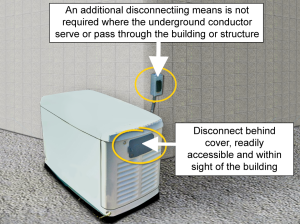How are 2023 NEC rules for outdoor generator inlets impacting portable generator installations?
Overview
Outdoor generators encompass a wide range of power generation solutions, serving diverse purposes, such as providing backup power for buildings and facilities with large permanent units, as well as supporting outdoor activities and emergencies with small portable generators. Previous editions of the NEC outlined installation requirements for both types of outdoor generators. However, they lacked specific guidelines regarding the placement of inlets for portable units, resulting in confusion and incorrect practices. To resolve this issue, the 2023 NEC introduced new requirements in Section 702.12. These requirements mandate that flanged inlets or other cord-and-plug-type connections for portable generators must be located outside buildings.
Previous editions of the NEC outlined installation requirements for both types of outdoor generators. However, they lacked specific guidelines regarding the placement of inlets for portable units, resulting in confusion and incorrect practices. To resolve this issue, the 2023 NEC introduced new requirements in Section 702.12. These requirements mandate that flanged inlets or other cord-and-plug-type connections for portable generators must be located outside buildings.
Applying the 2023 Code
Outdoor generators consist of a broad range of power generation solutions designed for diverse applications, from providing backup power to entire buildings and facilities to offering portable energy sources for outdoor activities or emergency situations. These generators come in two main categories: large units and portable units. Large outdoor generators are robust, high-capacity installations designed to provide a continuous power supply to critical infrastructure, such as hospitals, data centers, and industrial facilities, promoting uninterrupted operation. In contrast, portable outdoor generators are smaller units that offer versatility and mobility, making them well suited for powering outdoor events, construction sites, recreational vehicles, or providing temporary backup power to residential homes or small businesses.
In previous editions, NEC Section 702.12 outlined the guidelines for the installation and use of outdoor generator sets as emergency power systems in critical facilities. This section specified the installation requirements for different types of generator sets and equipment, including large permanently installed generators, portable generators exceeding 15 kW, portable generators less than 15 kW, and 100A power inlets for connecting with portable generators. While most portable generators require flanged inlets or other cord-and-plug-type connections to supply power to a building, the specific location of these inlets was not specified in previous editions of the NEC. This lack of clarity resulted in confusion and incorrect practices. In response, the 2023 edition of the NEC introduced a new requirement stipulating that flanged inlets and cord-and-plug connections must be situated outside buildings and structures, along with the portable generators they are connected to. This change was implemented to provide clarity regarding the location of inlets for portable generators.
What’s New for the 2023 NEC?
The table below presents a comparison between the 2020 NEC and the 2023 NEC regarding Section 702.12.
2020 NEC |
2023 NEC |
| 702.12 Outdoor Generator Sets
(A) Portable Generators Greater Than 15 kW and Permanently Installed Generators Where an outdoor housed generator set is equipped with a readily accessible disconnecting means in accordance with 445.18, and the disconnecting means is located within sight of the building or structure supplied, an additional disconnecting means shall not be required where ungrounded conductors serve or pass through the building or structure. Where the generator supply conductors terminate at a disconnecting means in or on a building or structure, the disconnecting means shall meet the requirements of 225.36. (B) Portable Generators 15 kW or Less Where a portable generator, rated 15 kW or less, is installed using a flanged inlet or other cord- and plug-type connection, a disconnecting means shall not be required where ungrounded conductors serve or pass through a building or structure. (C) Power Inlets Rated at 100 Amperes or Greater, for Portable Generators Equipment containing power inlets for the connection of a generator source shall be listed for the intended use. Systems with power inlets shall be equipped with an interlocked disconnecting means. Exception No. 1: If the inlet device is rated as a disconnecting means. Exception No. 2: Supervised industrial installations where permanent space is identified for the portable generator located within line of sight of the power inlets shall not be required to have interlocked disconnecting means nor inlets rated as disconnects. |
702.12 Outdoor Generator Sets
(A) Portable Generators Greater Than 15 kW and Permanently Installed Generators Where an outdoor housed generator set is equipped with a readily accessible disconnecting means in accordance with 445.18, and the disconnecting means is located within sight of the building or structure supplied, an additional disconnecting means shall not be required where ungrounded conductors serve or pass through the building or structure. Where the generator supply conductors terminate at a disconnecting means in or on a building or structure, the disconnecting means shall meet the requirements of 225.36. (B) Portable Generators 15 kW or Less Where a portable generator, rated 15 kW or less, is installed using a flanged inlet or other cord-and-plug-type connection, a disconnecting means shall not be required where ungrounded conductors serve or pass through a building or structure. The flanged inlet or other cord-and-plug-type connection shall be located outside of a building or structure. (C) Power Inlets Rated at 100 Amperes or Greater, for Portable Generators Equipment containing power inlets for the connection of a generator source shall be listed for the intended use. Systems with power inlets not rated as a disconnecting means shall be equipped with an interlocked disconnecting means. Exception: Supervised industrial installations where permanent space is identified for the portable generator located within line of sight of the power inlets shall not be required to have interlocked disconnecting means nor inlets rated as disconnects. |
